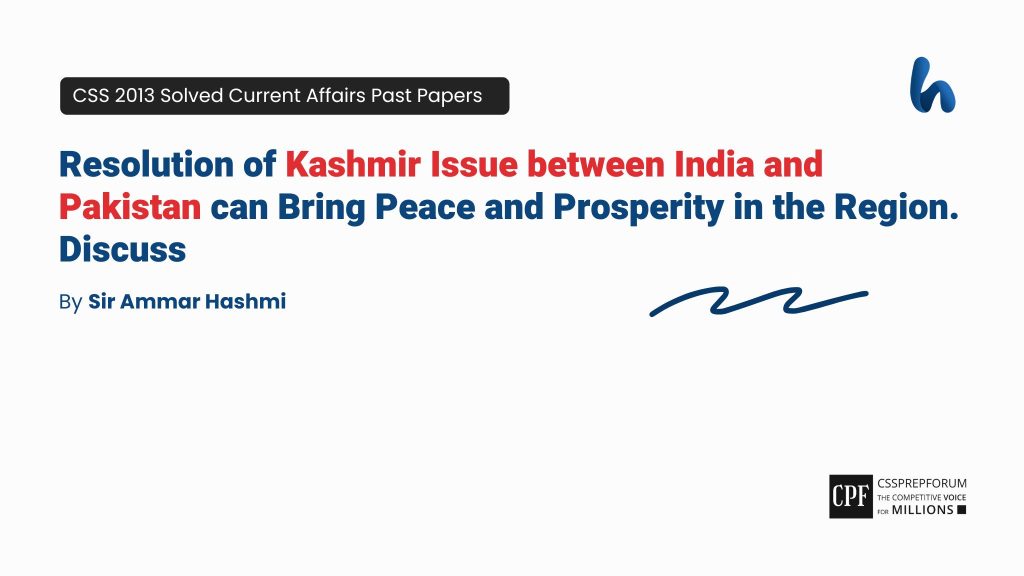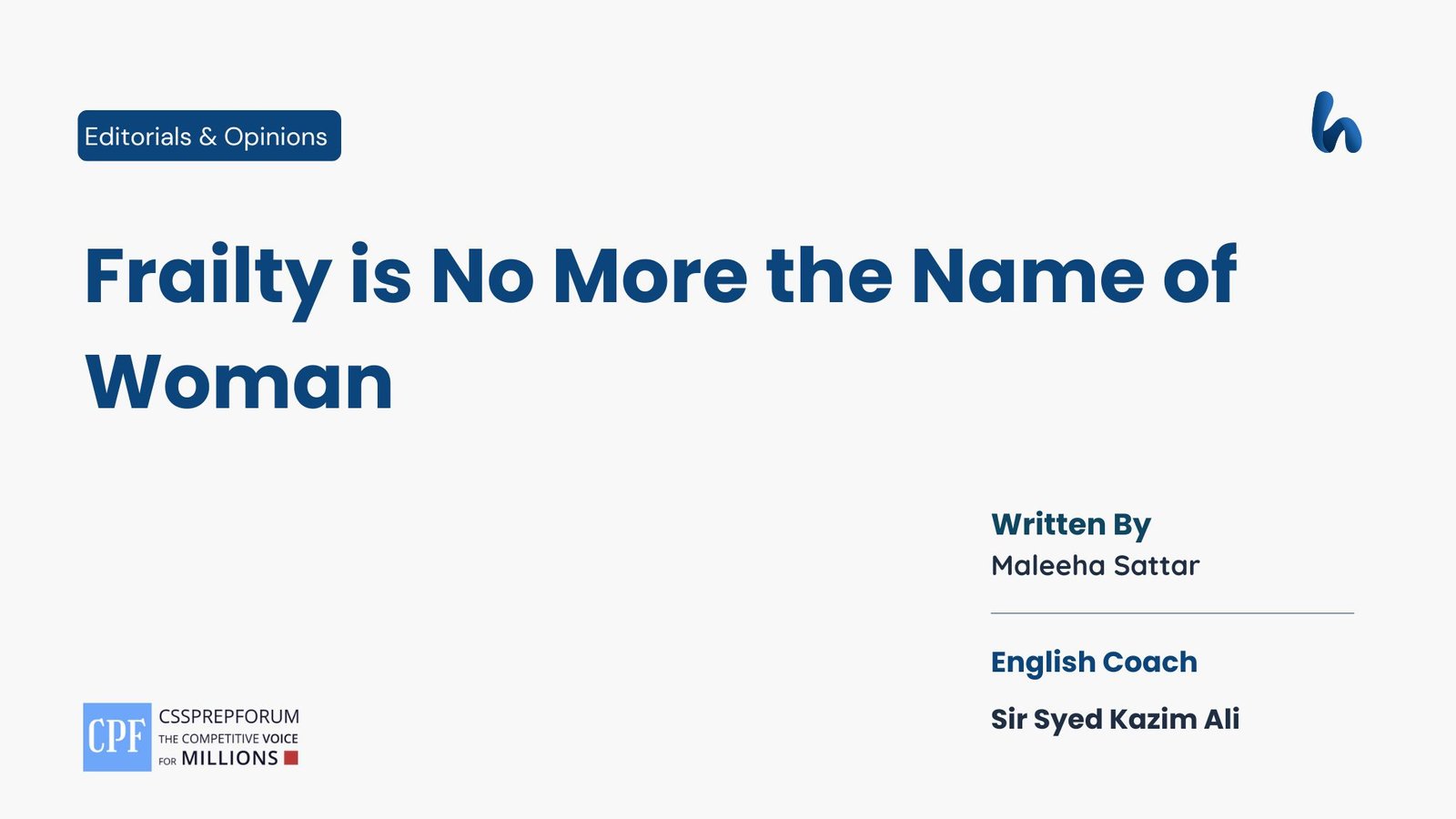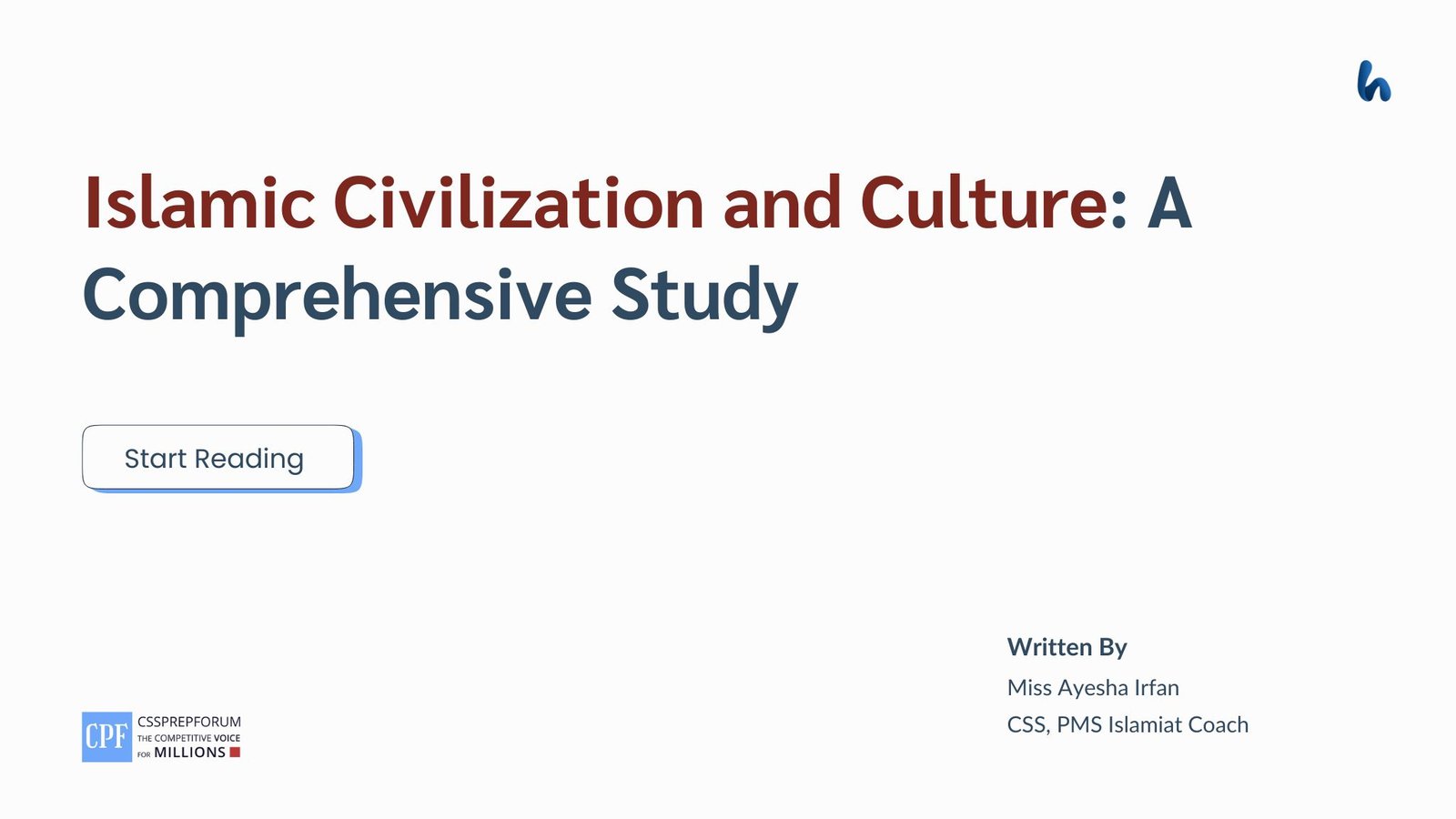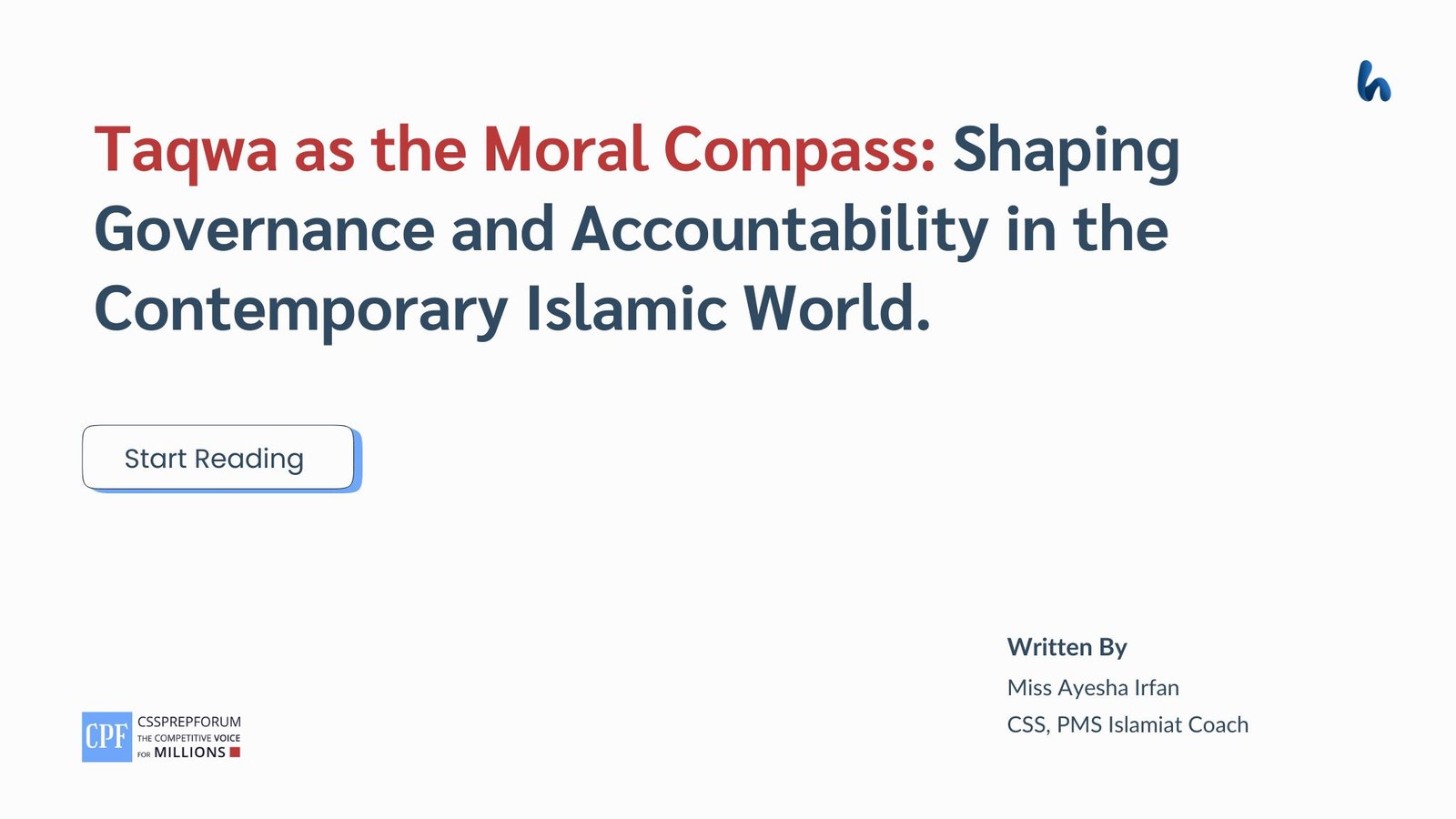CSS 2013 Solved Current Affairs Past Papers | Kashmir Issue and the Region’s Peace
The following question of CSS Current Affairs 2013 is solved by Sir Ammar Hashmi, the best Current Affairs Coach, on the guided pattern of Sir Syed Kazim Ali, which he taught to his students, scoring the highest marks in compulsory subjects for years. This solved past paper question is uploaded to help aspirants understand how to crack a topic or question, how to write relevantly, what coherence is, and how to include and connect ideas, opinions, and suggestions to score the maximum.

Question Breakdown
This question has one part in which we are supposed to discuss how resolving the Kashmir Issue between India and Pakistan can Bring Peace and Prosperity to the Region.
Outline
1-Introduction
2-Historical and Current Overview
3-Challenges in Resolving the Issue
4-Prospects of Peace and Prosperity in the Region
- ✓Economic Growth
- ✓Regional Integration
- ✓Reduction in Military Expenditure
- ✓Security and Stability
- ✓Improved Diplomatic Relations
- ✓SAARC Revitalization
- ✓Global Peace Contribution
- ✓Human Rights and Development
5-Critical Analysis
6-Conclusion

Answer to the Question
Introduction
The issue of Kashmir is one of the oldest Indo-Pakistan territorial disputes, which goes back to the time since the emergence of both India and Pakistan in 1947 and indeed remained the biggest hurdle in achieving a positive climate in the South Asian region. In the past decades, problems, political instabilities, and various tensions have been witnessed, including recent tensions like Article 370. The ongoing conflict affects the diplomatic relations between the two nuclear powers and is disastrous for economic, security and humanitarian. Despite all these aspects, they have not been able to come up with the limbic that would help work towards overcoming or even eliminating the barriers of mistrust and geographical enmity that stand in the way of the search for the solution. Nevertheless, the case has significant potential to transform the area if the conflict is resolved peacefully. Different pathologies of labour organizations, economic cooperation between regions, and the rehabilitation of violated rights of the Kashmiri people can enhance the population’s quality of life, reduce military spending, and increase international security. Therefore, the dialogue approach and the positive effects of each other for the two parties to the conflict over Kashmir should be followed for continuous development in the region. Therefore, it is the desire to achieve relative peace in the area and bring positive results for the area that transcends the region and becomes a concern for the global community and global welfare.
Historical and Current Overview
The origins of the Kashmir conflict go back to 1947 when the British partition occasioned confusion about the future of Jammu and Kashmir. The selection by the Maharaja to be in line with India sparked the first series of frictions with Pakistan, which led to a division along the Line of Control. The separation has continued since both nations got involved in conflicts in 1965 and 1999 that failed to produce permanent fixes. In 2019, the situation became worse when India took back Article 370, which reduced the unique status of Kashmir and escalated tensions considerably. Performing this action has fostered a worsening of the humanitarian crisis in that part of the world and exacerbates historical resentments and abiding disputes over territory. This crisis emphasizes considerable political and military inquiries that desperately seek a collective remedy, mainly because it has extended impacts on regional stability and security.
Challenges in Resolving the Issue
The Kashmir issue poses numerous challenges that hinder a resolution between India and Pakistan. Although the division of the area and subsequent conflicts have created more significant challenges, the circumstances of modern political and humanitarian issues in Kashmir have worsened things. Various barriers hinder fundamental advances toward peace since the conflict has yet to be settled. The disagreement’s root is in the aspirations for territory held by India and Pakistan because neither side wants to surrender sovereignty. As a result, the two nations have a severe deficit of trust, making it very hard to explore diplomatic options. The negotiations are experiencing a higher degree of complexity owing to the inputs of key powers motivated by their strategic considerations in that region. The Kashmiri people’s enduring hopes for either enhanced autonomy or total independence produce more layers of complexity. The serious humanitarian crisis has been induced by violations of human rights, regular curfews, and curbs on the population. Moreover, the economic weight of the conflict has changed where necessary resources go, thus making instability worse. Progress towards peace is fundamentally contingent on the Kashmiri people’s participation in any future negotiations, enhancing trust by demilitarizing the area and solving essential political problems despite the hurdles. Achieving a tranquil settlement of this problem is possible by concentrating on humanitarian concerns and coordinating regionally.
Prospects of Peace and Prosperity in the Region
- ✓ Economic Growth
A peaceful ending of the conflict over the territory of Kashmir may promote tremendous economic progress in the territory. Due to the natural scenery and geographical features, the Tour is the main activity in which the region of Kashmir has suffered dramatically due to the continuing conflict. Tourism can develop if there is a chance to achieve stability. Therefore, people within countries and other tourists will be visiting the country, thus being an added advantage in the economy and job offerings. Tourism, agriculture, and handicrafts are two significant sectors of Kashmir. It could open more markets to these sectors and investment for growth. Less military spending by India and Pakistan will allow both of them to focus on physical and communication and other upgrading of infrastructure, as well as on business potential, leading to a steady economic growth of the region.
- ✓ Regional Integration
Apart from this, a peaceful ending of the Kashmir conflict may provide a framework for increasing economic interdependence and political integration between India, Pakistan and Kashmir. Due to improved transportation and infrastructural conditions, the area could become a trading and commercial centre of Central Asia connected with South Asia. The textile, agriculture, and energy sectors may have prospects of mutually beneficial trade between India and Pakistan. Additionally, coordination in the exploitation of shared assets might be better managed, for instance, in the case of water in the Indus River, reducing conflict of water entitlements. Last of all, regional integration will enhance the development of the economy and create common ground for intercontrol and intercommunication. This will improve the promotion of everlasting order and peace.
- ✓ Reduction in Military Expenditure
Moreover, peaceful extrapolation of the dispute also provides ways to reduce the military spending of both India and Pakistan- now perpetuated by border tensions and the ever-present possibility of war. Both have been devoting a large part of their budgets for the last several decades to maintaining a steep troop presence on the LoC, diverting cash that could have been useful for development. Such funds directed towards the military should be invested not only in core social needs such as poverty and unemployment but also in education, health and infrastructure. In this sense, Pakistan might benefit from lesser military spending by focusing the state on its economic rehabilitation. Thus, it will, for sure, improve the living standards of millions of people by reducing expenditure on defence and creating fiscal space for balanced economic growth and development.
- ✓ Security and Stability
Moving further, solving the question on the territory of the disputed territory of Kashmir will strengthen the region and help increase stability throughout South Asia. This conflict has resulted in now and then violence, rebellion, and increased militarization in the region. It would remove such tensions, allowing India and Pakistan to reduce their military strength and rely on collective security cooperation. Moreover, decreasing the possibility of cross-border terrorism and militancy will make borders more secure and relations more robust, reducing the chances of future confrontation. This peace will benefit Kashmir and the general region as a new safety platform for economic and social development is created.
- ✓ Improved Diplomatic Relations
Similarly, resolving the Kashmir issue will dramatically change the nature of the diplomatic relations between the two countries, which would enhance cooperation. The two have deteriorated during the conflict, and the prospects for partnership in various spheres, including business and energy, have come down. Without ‘peace’, this hindrance may stand in the way of the two nations partnering on a project to boost the economic and technical frontiers. Both parties would stand to gain in terms of increasing their foreign commerce and embarking on participation in infrastructural partnership projects. Besides, the economic benefits would supplement diplomatic liberalization in the area and foster less conflict in the South Asian region, making the already vast region more effectively address broad challenges.
- ✓ SAARC Revitalization
With improved diplomatic relations between India and Pakistan, the potential for revitalizing the South Asian Association for Regional Cooperation (SAARC) would significantly increase; in the past, disputes over the territory of Kashmir have posed problems for the organization’s functioning; however, the demilitarisation of these disputes may remove some of these hurdles and open the way towards closer cooperation. Integration can produce great economic activities like trade and infrastructure within SAARC and South Asia. Partnerships and cooperation agreements in the energy and transport field could enhance links between all member states and the growth potential. Therefore, with time and support for integration and unity in the SAARC, the organization’s inherent goals of promoting peace, security, and development could be realized.
- ✓ Global Peace Contribution
The peaceful resolution of the Kashmir problem would affect regional processes and significantly improve worldwide peace processes. The reduction of tensions between two nuclear-armed neighbours would reduce the incidence of nuclear conflict and, therefore, ease world concerns. Perhaps the settlement may be a pointer to how the other territorial issues will be dealt with within this diplomatic defeat or triumph of violence. Besides, strengthened relations between India and Pakistan will allow those states to become more involved in pull-resolution international associations and forums. Thus, peace in the region helps South Asian countries but simultaneously acts as an organization for the betterment of the world’s stability and security.
- ✓ Human Rights and Development
The overarching security within the region and across the globe is likely to augment once the issue of Kashmir is resolved, and in general, the well-being of the people within the region will improve in the process, thereby offering a way forward towards the region’s development. The continual militancy has impacted the people of Kashmir – their freedom rights and their freedoms to even essential services like schools and hospitals are limited. Again, tensions would hamper any such coordinated efforts, but limitations would be relatively low with peace, construction, rebuilding, and development. Then, the people of Kashmir could divert their energies to the development of their society. Some schools and hospitals that may have experienced violence would begin to be reconstructed, while other development projects to enhance the people’s standard of living could start to be undertaken. It would solve such complaints and promote long-term developmental processes in society and the economy.
Critical Analysis
A critical analysis of the conflict in Kashmir shows the entrenched nature that bars any chance of resolution. Regarding the future features, the options for peace and prosperity look bright. However, they are not easily attainable due to the overly strengthened positions of both Indian and Pakistani political and ideological foundations. For this reason, even when the conflict has involved issues of a territorial nature, factors of pride and history have played a hand in developing such conflicts; hence, it will be hard for parties to compromise. Furthermore, other international actors have essential stakes in preserving or changing the status quo in the region. For instance, China and the USA provide colour to the situation by interfering with diplomats’ actions in pursuing their goals. People in Kashmir are trapped between two layers of conflict and human rights abuse: first, from the Indian Armed Forces and second, from the armed groups that perpetrate violence within the region. As much as dialogue is depicted as the solution to the problem, the previous attempts have not been much of an influence because of the lack of trust from the dialogue partners. Both nations must let go of their prejudices dating back to history, exit the era of exclusive militarization, and go towards diplomacy. Furthermore, it means that if any resolution is to be met, then it can only be done by raising the voices of the Kashmiri people, as they are the sufferers of this colossal struggle. The attainment of peace involves aspects such as negotiations. However, there is also a need to change the political culture where conflicts are fought with haste rather than heeding the long-untangled peace.
Conclusion
To conclude, the solution to the problem of the disputed territory of Kashmir is historic for India, Pakistan and South Asia as a whole. There is no doubt that there are challenges, such as considerable distinctions in the political systems of countries within the region and humanitarian crises; however, there are many factors which depict opportunities to establish peace and pave the way for economic development and security of the region and its partnership with other countries. Through solving such concerns by diplomatic means, none of the states would be involved in the conflict, and both countries might invest their resources in the development and stability of the region; however, it does not mean that the only way to forge ahead is to diligently continue the ongoing conversations, build trust, and be proactive in embracing the perspectives of the people of Kashmir. Hence, the future is about the integrity of the physical space of Kashmir and is fundamental to defining stable, secure, and prosperous outcomes for millions living in the region.
CSS Solved Past Papers’ Essays
Looking for the last ten years of CSS and PMS Solved Essays and want to know how Sir Kazim’s students write and score the highest marks in the essays’ papers? Then, click on the CSS Solved Essays to start reading them.
CSS Solved Essays
CSS Solved General Science & Ability Past Papers
Want to read the last ten years’ General Science & Ability Solved Past Papers to learn how to attempt them and to score high? Let’s click on the link below to read them all freely. All past papers have been solved by Pakistan’s top CSS GSA coach having the highest score of their students.
General Science & Ability Solved Past Pape












